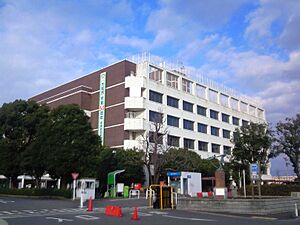Yamato, Kanagawa facts for kids
Quick facts for kids
Yamato
大和市
|
|||
|---|---|---|---|

Yamato City Hall
|
|||
|
|||

Location of Yamato in Kanagawa Prefecture
|
|||
| Country | Japan | ||
| Region | Kantō | ||
| Prefecture | Kanagawa | ||
| Area | |||
| • Total | 27.09 km2 (10.46 sq mi) | ||
| Population
(June 1, 2021)
|
|||
| • Total | 242,065 | ||
| • Density | 8,935.6/km2 (23,143/sq mi) | ||
| Time zone | UTC+9 (Japan Standard Time) | ||
| City symbols | |||
| • Tree | Yamazakura (Prunus jamasakura) | ||
| • Flower | Nogiku (a group of Asteraceae) | ||
| • Bird | Azure-winged magpie | ||
| Phone number | 046-263-1111 | ||
| Address | 1-1-1 Shimotsuruma, Yamato-shi, Kanagawa-ken 242-8601 | ||
Yamato (大和市, Yamato-shi) is a cool city in central Kanagawa Prefecture, Japan. As of June 1, 2021, about 242,065 people lived there. This means it's a pretty busy place, with around 8900 people per square kilometer! The city covers an area of about 27.09 square kilometers.
Contents
Exploring Yamato's Location and Landscape
Yamato is located about 40 to 50 kilometers away from the big city of Tokyo. It's also only about 20 kilometers from Yokohama, another major city. The city is shaped like a long, narrow rectangle, stretching about 9.79 kilometers from north to south. It's only 3.22 kilometers wide from east to west.
Yamato sits on the Sagamino Plateau, which is a gently sloping area. This means there are almost no big hills in the city. The highest point is 90 meters above sea level, near the Shimotsuruma Asama Shrine. The lowest point is 30 meters above sea level.
Neighboring Cities and Towns
Yamato is surrounded by several other cities in Kanagawa Prefecture:
- Zama
- Fujisawa
- Ebina
- Sagamihara
- Ayase
- Yokohama
It also borders one city in Tokyo:
Yamato's Climate and Weather
Yamato has a humid subtropical climate. This means it has warm summers and cool winters. Sometimes, there might be a little snow, but usually not much. The average temperature in Yamato is about 14.9 degrees Celsius (around 59 degrees Fahrenheit).
The city gets a good amount of rain, about 1632 millimeters (64 inches) each year. September is usually the wettest month. The warmest month is August, with temperatures around 25.7 degrees Celsius (78 degrees Fahrenheit). January is the coldest month, with temperatures around 4.3 degrees Celsius (40 degrees Fahrenheit).
Yamato's Growing Population
Over the past 70 years, the number of people living in Yamato has grown a lot. This shows how popular the city has become!
| Historical population | ||
|---|---|---|
| Year | Pop. | ±% |
| 1950 | 22,326 | — |
| 1960 | 40,975 | +83.5% |
| 1970 | 102,760 | +150.8% |
| 1980 | 167,935 | +63.4% |
| 1990 | 194,866 | +16.0% |
| 2000 | 212,761 | +9.2% |
| 2010 | 228,186 | +7.2% |
| 2020 | 239,169 | +4.8% |
A Look Back at Yamato's History
People have lived in the area where Yamato city is now for thousands of years! Archaeologists have found old stone tools and pottery pieces from ancient times. This tells us that people were here even before recorded history.
The area is mentioned in old Japanese records from the Heian period (794-1185). Later, during the Kamakura period (1185-1333), it became part of a large estate called Shibuya shōen. Over the centuries, different powerful families, like the Ashikaga clan and the Later Hōjō clan, controlled this land.
When the Edo period (1603-1868) began, the area was directly controlled by the Japanese government, called the Tokugawa shogunate. In 1682, a local leader named Sakamoto Shigeharu became a daimyō (a powerful feudal lord) of a new area called Fukami Domain. However, his power didn't last long, and the domain was soon closed.
Modern Yamato Takes Shape
After the Meiji Restoration in 1868, which brought big changes to Japan, the Yamato area became part of Kanagawa Prefecture. In 1889, it was divided into two villages: Shibuya Village and Tsurumi Village. Tsurumi Village later changed its name to Yamato Village in 1891.
Trains arrived in the area in the 1920s, which helped the population grow. The Imperial Japanese Navy also built an air base nearby in 1940. Yamato Village officially became Yamato Town in 1943. Shibuya Village became Shibuya Town in 1944, but it later split up, with part of it joining Yamato in 1957. Finally, in 1959, Yamato became a full-fledged city!
In April 2000, Yamato's population grew to over 200,000 people. Because of this, it was named a "special city," which means it gained more local control over its own affairs.
In 2020, Yamato made news around the world for being the first city to make it against the rules to walk in certain areas while looking at your smartphone. They didn't add a fine, but it was a way to encourage people to be more aware of their surroundings.
Learning in Yamato: Schools and Colleges
Yamato takes education seriously! The city has many schools for children of all ages.
- There are 19 public elementary schools.
- There are 9 public middle schools.
- The Kanagawa Prefectural Board of Education runs 4 public high schools.
- There are also 2 special education schools for students with disabilities.
- Yamato also has one private elementary school, one private middle school, and one private high school.
- For those who want to continue their studies after high school, there's the St. Cecilia Women's Junior College located right in Yamato.
Getting Around Yamato: Transportation
Yamato has a good transportation system, especially with its railway lines, making it easy to travel to and from the city.
Railway Lines in Yamato
 Tokyu Corporation Tōkyū Den-en-toshi Line
Tokyu Corporation Tōkyū Den-en-toshi Line
- Chūō-Rinkan
- Tsukimino
 Odakyu Electric Railway – Odakyū Enoshima Line
Odakyu Electric Railway – Odakyū Enoshima Line
- Chūō-Rinkan
- Minami-Rinkan
- Tsuruma
- Yamato
- Sakuragaoka
- Kōza-Shibuya
 Sagami Railway - Sotetsu Main Line
Sagami Railway - Sotetsu Main Line
- Sagami-Ōtsuka
- Yamato
Major Highways in Yamato
Several important roads pass through Yamato, connecting it to other parts of Japan:
 Tōmei Expressway
Tōmei Expressway National Route 16
National Route 16 National Route 246
National Route 246 National Route 467
National Route 467
Yamato's Sister Cities
Yamato has special friendships with other cities, both in Japan and around the world. These are called "sister cities" or "twin towns." They often share culture and ideas.
Famous People from Yamato
Many talented people have come from Yamato! Here are a few:
- Jungo Fujimoto, a professional football (soccer) player
- Mitsuko Horie, a singer and voice actress
- Ryuichi Kawamura, a singer-songwriter
- Takeo Kawamura, a professional baseball player
- Eiko Kawashima, a singer-songwriter
- Nahomi Kawasumi, a professional football (soccer) player
- Masahiko Kondō, a singer
- Hiroshi Nagano, a singer and actor, known from the Japanese boy band V6
- Noriko Narazaki, a judoka (a person who practices judo)
- Shinobu Ohno, a professional football (soccer) player
See also
 In Spanish: Yamato (Kanagawa) para niños
In Spanish: Yamato (Kanagawa) para niños




